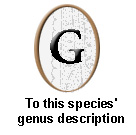

Differential diagnosis: Funaria cacti resembles F.
obtusa, but can be distinguished by the more prominent, wider spear
and longer tail.
The specific epithet cacti refers to the vegetation in the type
habitat.
Holotype female: Body arcuate, cylindroid. Cuticle with fine striations; subcuticle coarsely striated, loose and sunken. Radial refractive elements present; lateral cords 8 um wide. Body pores apparently arranged in two rows. Head offset, 11 um wide; papillae distinct. Amphids duplex about 6.4 um wide; stoma cuticularized 6.4 um long. Spear 10 um long, robust, lumen distinct; spear extension about as long as spear, prominent, cuticularized. Nerve ring located at about 38% of esophageal length. Esophageal bulb long, cylindrical; cardia large and distinct. Vulva longitudinal; vagina about 21 um long. Didelphic, amphidelphic ovaries symmetrical, 13% of body length; reflexed about 50%. Prerectum distinct; intestine-prerectum junction guiarded by three prominent cells. Rectum length about 26 um; anal body width 25 um. Tail bluntly conoid; caudal papillae and terminal papilla present.
Paratype male: Testes two, outstretched; sperms cylindrical to spindle-shaped. Spicules dorylaimoid with lateral guiding pieces. Ventromedian supplements 7 to 8, well-spaced, the series starts about 60 um from the adanal pair. Male tail longer, more arcuate and more conoid than that of female. Caudal papillae including terminal papilla present.
Discussion: With the bluntly conoid tail this species closely resembles Funaria obtusa, but can be distinguished by the longer tail and wider spear. The spear, with a distinct lumen, is quite similar to that observed in F. fimbriata (Thorne, 1939) and is different from that of the other Funaria species which possess a more slender spear with lumen less distinct.
Distribution and Habitat: Two females, several males and
three juveniles found near Portal, Arizona. Site very rocky; vegetation
composed of several kinds of cactus. Collected by J. and V. Ferris,
July 23, 1969.
(Description- Goseco, Ferris and Ferris, 1974)
DNA Sequences Obtained
| Specimen: | Collected: |
| 9 Mile12-28 LP2-39 | 9 Mile Prairie, First survey |
 |
 |